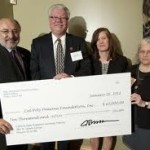Buildings and development provide countless benefits to society. Yet, buildings are the nation’s biggest polluters. According to the Environmental Protection Agency, buildings accounted for 72 percent of total U.S. electricity consumption in 2006 and this number will rise to 75% by 2025.
Nobody understands this better than HMC Architects (a 360-person architecture firm). Since 1940, HMC’s work has been driven by the belief that design can change the world. They’re passionate about putting design to work in service of larger, more meaningful goals, whether societal, educational, medical, or cultural.
HMC’s social responsibility program can serve as a model for any professional service firm interested in leveraging its knowledge, expertise and employees in ways that contribute to a better world while boosting its brand.
Strategy
HMC’s designed its social responsibility program to advance its brand in key markets, including, schools, hospitals and municipal buildings throughout CA, AZ and NV. HMC’s social responsibility efforts link to key client markets and leverage its core competencies. This strategic approach to social responsibility helps HMC achieve maximum social impact while advancing the HMC brand in key industries.
 Designing Futures Foundation (DFF). In 2009, HMC established the Designing Futures Foundation, a nonprofit scholarship foundation aimed at supporting the communities and markets in which it works. Since its inception DFF has donated $230,000, including $105,000 in scholarships to California high school students interested in pursuing studies in architecture, design, engineering, education and healthcare.
Designing Futures Foundation (DFF). In 2009, HMC established the Designing Futures Foundation, a nonprofit scholarship foundation aimed at supporting the communities and markets in which it works. Since its inception DFF has donated $230,000, including $105,000 in scholarships to California high school students interested in pursuing studies in architecture, design, engineering, education and healthcare.
The Foundation has launched a Community Project initiative that encourages HMC employees to propose projects for funding that positively impact the communities in which they live and work. Grant awards range from $1,000-$10,000. To date, the Designing Futures Foundation has:
- Provided a $10,000 seed grant to help Cal Poly Pomona start a healthcare architecture studio, the first of its kind west of the Mississippi.
- Worked with Harvey Mudd College and the California Institute of the Arts on a project that uses online games and resources to foster greater environmental responsibility among college students.
- Funded an $18,000 water demonstration garden at Norco College, a two-year institution in Riverside.
- Sponsored research by HMC staff and consulting experts at UC San Diego’s Calit2 StarCAVE virtual reality environment on the effects of the built environment on building users.
Pro-Bono Projects. HMC encourages employees to submit ideas for community projects that advance its CSR goals. As a professional service firm, HMC sought to leverage its internal expertise and signed onto the national Billion Plus Change initiative, which encourages companies to devote pro-bono work to social and environmental causes. Under this initiative, the DFF awarded a Community Project Grant for a recent project to restore the historic Micheltorena Steps in Silver Lake, California.
HSC employee Scott Plante, who lives nearby and uses the steps, conceived of the project after recognizing safety issues with children and the adjacent school. The Micheltorena Steps were selected as a prototype for repairing and relighting similar steps throughout the neighborhood.
“This project perfectly blends our skills in architecture and education,” says Luce. “We do a lot of work in L.A. County, so this effort aligns with our business goals.”
See the video about the DFF and the Micheltorena Steps project at: www.BDCnetwork.com/HMC/DFF.
Youth Environmental Education. Pablo La Roche, HMC Architects’ director of sustainable design, teamed with his son’s local elementary school to deliver a program that would build early awareness of energy, waste, and water issues among students in one of HMC’s key markets.
“When we think about sustainability and elementary schools, we often think about sustainable-design practices and building materials, but seldom do we think about sustainability education for young students,” says La Roche. “In April 2011, I began thinking that it was only natural to approach my son’s school about developing a sustainability program, and a couple of months later, I was able to secure a community-project grant from my firm’s Design Futures Foundation, to develop three activity-based workshops covering water, energy, and waste.”
The workshops, which included lessons in water conservation, renewable energy, and reducing waste in landfills included grade-specific interactive lessons with videos and hands-on group activities to reinforce concepts. As the project took shape, La Roche was eager to reach more students, and even included another elementary school in Venezuela via Skype. “This opportunity to connect with students half a world away demonstrated to all of the students—at McKinley and in Marcaibo—how global the world’s environmental issues are.”
HMC now sees its “Sustainable Environments Seen Through the Eyes of Elementary School Children” workshops as a model for introducing youth everywhere to environmental challenges while promoting sustainable living. HMC hopes to publish a teacher’s handbook so that the program, tools and materials can be used by teachers in schools throughout the United States. “It is my hope that teaching children about sustainability will not only resonate with them, but also with their parents, for the rest of their lives,” says La Roche.
Results
HMC’s employees enjoy the positive impact their making on the community, the environment and for our field as a whole (architecture, design and sustainability). HMC has received considerable recognition for its efforts, including honors by the U.S. Green Building Council(USGBC) Volunteer IMPACT! Award. The Santa Monica Malibu United School District invited HMC to record its workshops in a television studio and the Los Angeles United School District has plans to broadcast the programs to multiple schools. Moreover, HMC has enjoyed the following benefits from its ongoing commitment to social responsibility:
1. Internally boosting employee moral and loyalty
2. Demonstrating industry thought leadership that creates a competitive long-term advantage
3. Strengthens our relationships in the community, with our peers, and clients
What can small and medium businesses and professional service firms learn from HMC? The key is aligning social responsibility with core business goals.
“When professional services firms enact social responsibility programs that flow from your skills and assets, and really speak to your target market, you’ll generate benefits for your company, engage your key stakeholders, strengthen your brand and elevate your business in your community. It’s a win-win for everybody.”








CONNECT WITH US!